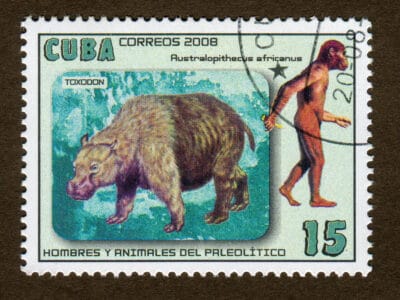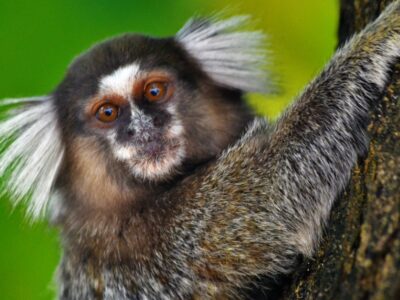Endangered animal categories, definitions, and lists
A-Z Animals follows the International Union for the Conservation of Nature (IUCN)’s nine categories of endangered animal lists. They are:
 | Extinct (EX) — Extinct species no longer exist. After exhaustive research, scientists around the world agree that there isn’t a single living individual of the species on the planet. Interestingly, 99 percent of all species that ever graced the Earth over the past five billion years have gone extinct. Read more and see an extinct species list here. |
 | Extinct in the wild (EW) — Species that only survive in captivity, cultivation, or outside their native range are deemed “extinct in the wild.” For example, if only 10 individuals of a rare bird are left, and they all live in zoos or on a single nature preserve, the IUCN would classify the species as extinct in the wild. Read more and see an extinct in the wild species list here. |
 | Critically endangered (CR) — Critically endangered species are on the brink of becoming extinct or extinct in the wild but have not yet met the criteria for either category. See a list of critically endangered species here. |
 | Endangered (EN) — Endangered species are at a very high risk of becoming extinct in the wild or extinct. For an animal to be added to the category, it must meet specific criteria regarding population or habitat decline, which you can read about on our endangered species list. |
 | Vulnerable (VU) — Vulnerable species meet at least one of the five Red List criteria. They’re considered to be at high risk of human-caused extinction if conservationists don’t intervene. For the IUCN to add a taxon to the Vulnerable animals list, it must meet specific criteria regarding population or habitat decline. Read more on our vulnerable species list here. |
 | Near threatened (NT) — A species is considered Near Threatened when it doesn’t qualify as Critically Endangered, Endangered, or Vulnerable, but scientists believe it will reach one of those levels in the near future. See our near threatened species list here. |
 | Least concern (LC) — Species that fall into the Least Concern category are not presently facing any population or habitat declines. See a least concern species list. |
 | Data deficient (DD) — Data deficient species lack enough information to properly categorize into one of the groups above. See a data deficient species list. |
 | Not evaluated (NE) — This species has not been evaluated for an IUCN categorization yet. See a list of not evaluated species. |
What is the International Union for the Conservation of Nature (IUCN)?
The IUCN is the organization that monitors the conservation status and other ecological metrics for the world’s plants and animals. Its mission is to promote sustainable use of the Earth’s resources.Founded in 1948, in Fontainebleau, France, as the Union for the Protection of Nature, the IUCN is the oldest global environmental advocacy group. Today, headquartered in Gland, Switzerland, the umbrella organization collaborates with over 1,000 smaller nonprofits, associations, and governments representing 140 countries.
How Many Species Occupy the Earth?
The IUCN monitors the world’s species, which raises the question: How many species currently occupy the planet?In 2016, researchers declared their collective belief that over one trillion species currently occupy the Earth. However, scientists have only observed and described about one-thousandth of one percent of them, or 7 to 10 million.The typical lifespan of a species is 10 million years. However, some stick around for hundreds of millions of years. For example, jellyfish have lived on Earth for nearly 550 million years!
What is a Taxon?
The IUCN frequently uses the word “taxon.” So what is it? A taxon is a group of one or more populations of a species or organism that form a unit.
What is the Red List?
The International Union for the Conservation of Nature is perhaps best known for creating the IUCN Red List of Threatened Species, a detailed accounting of the world’s vulnerable and endangered species. The list started in 1964 and details at-risk taxons, for both plants and animals, which are separated into several categories.
How Many Animals are Currently Endangered?
You may be wondering: How many animals are endangered, or what animals are endangered in 2020? For the most recent version of the list, IUCN researchers and scientists evaluated 63,837 species. Of that number, 19,817 are threatened with extinction; 3,947 landed in the Critically Endangered category; 5,766 qualified as Endangered, and over 10,000 species are listed under Vulnerable.
What is the Endangered Species Act?
Passed in 1973, the Endangered Species Act is a federal United States law designed to protect threatened and endangered species that are imperiled because of a “consequence of economic growth and development untempered by adequate concern and conservation.” The goal of the act is to prevent extinction and recover species to the point where they no longer need protection.
Extinct Animals
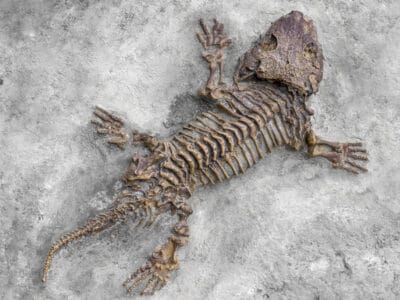
Seymouria
Although Seymouria had so many reptilian features, it was an amphibian
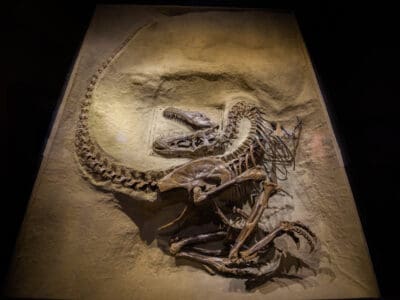
Gorgosaurus
Gorgosaurus probably lived and hunted in packs.
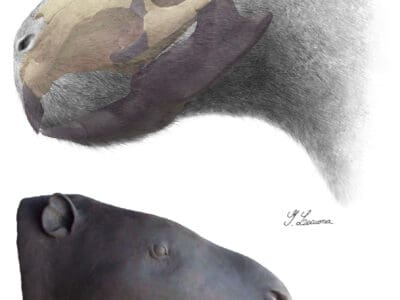
Josephoartigasia monesi
Josephoartigasia monesi the largest known rodent
See all of our extinct animals.
Extinct in the Wild Animals

Scimitar-horned Oryx
Believed to be the inspiration for unicorn myths!
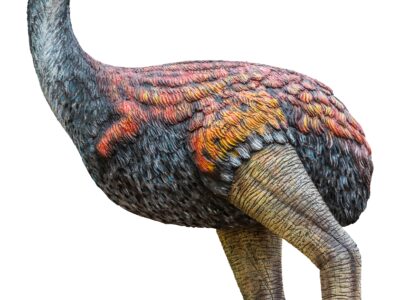
Elephant Bird
Vorombe titan, a type of elephant bird, is the largest bird that ever lived
See all of our extinct in the wild animals.
Critically Endangered Animals

Gooty Sapphire Tarantula
They can run up a tree trunk surprisingly fast.
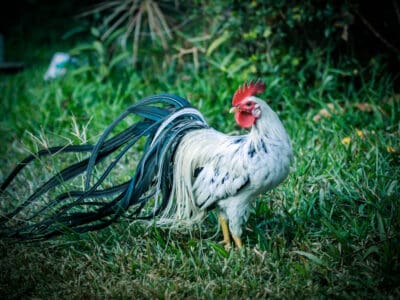
Onagadori Chicken
The Onagadori, the chicken with the world's longest tail, was declared a Natural Monument of Japan in 1952.

Aruba Rattlesnake
This rattlesnake only lives on the island of Aruba.
See all of our critically endangered animals.
Endangered Animals

Florida Panther
Florida panthers can leap more than 4.5 meters (15 feet) in the air.
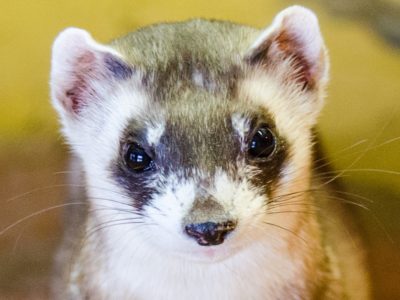
Black-Footed Ferret
Black footed ferrets are the only ones native to North America.
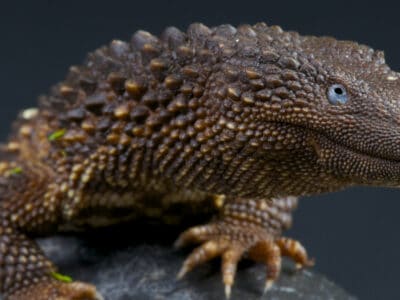
Earless Monitor Lizard
These lizards can practically shut down their metabolism and appear comatose for long periods.
See all of our endangered animals.
Vulnerable Animals

Indian Star Tortoise
Popular in the exotic pet trade!

Golden Mole
The golden mole is so named because of its iridescent coat, which gives it a shining, rainbow-like effect.
See all of our vulnerable animals.
Near Threatened Animals
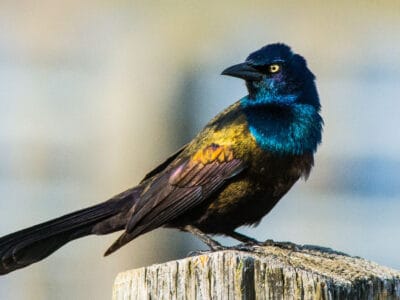
Common Grackle
Common grackles are a pest species that damage crops and spread disease.

Siberian Ibex
There’s a population of Siberian ibex in New Mexico
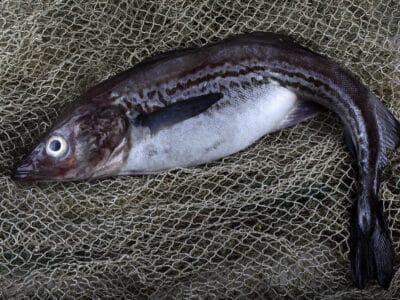
Alaskan Pollock
It's one of the most commonly eaten fish in the world
See all of our near threatened animals.
Least Concern Animals
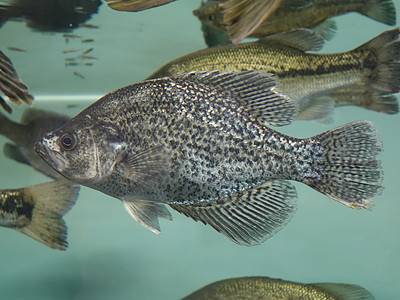
Crappie Fish
The crappie is one of the most popular freshwater fish in North America.
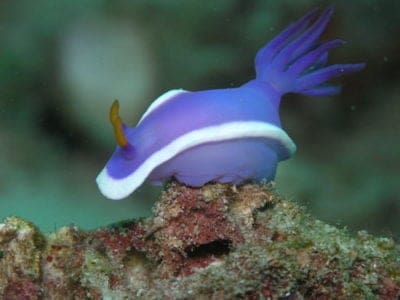
Sea Slug
All sea slugs have both male and female sex organs

Fancy Mouse
Fancy mice are beloved pets with a history of domestication spanning thousands of years!
See all of our least concern animals.
Data Deficient Animals
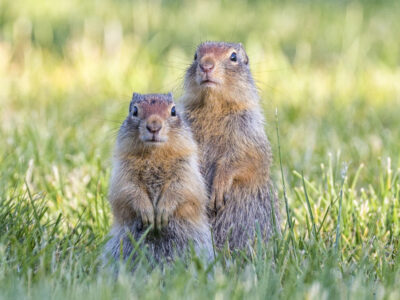
Ground Squirrel
Ground squirrels are adept excavators and can dig colonial burrows larger than football fields!
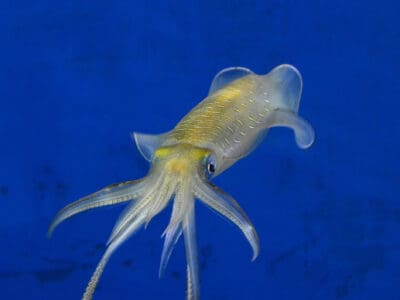
Bigfin Reef Squid
Can change color through use of chromatophores
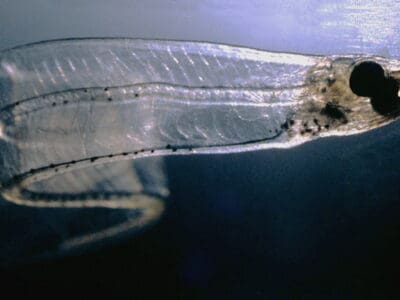
Leptocephalus
Leptocephali have flat bodies filled with jelly-like substances, surrounded by a thin layer of muscle.
See all of our data deficient animals.
Not Evaluated Animals

Earthworm
They are hermaphrodites, which means they have male and female organs

Sandworm
Legs also function as gills

Keta Salmon
During spawning the look of the male changes. Among other things, he grows a beak called a kype that bears fangs.
See all of our not evaluated animals.
The Big List of Endangered Animals
List of Extinct Animals
- Albertonectes
- Allosaurus
- Allosaurus
- Amargasaurus
- Amphicoelias Fragillimus
- Andrewsarchus
- Anomalocaris
- Anteosaurus
- Arambourgiania
- Archaeoindris
- Archaeopteryx
- Archaeotherium
- Archelon Turtle
- Arctodus
- Arctotherium
- Argentavis Magnificens
- Argentinosaurus
- Arsinoitherium
- Arthropleura
- Aurochs
- Australopithecus
- Barinasuchus
- Barosaurus
- Barylambda
- Basilosaurus
- Brachiosaurus
- Bull and Terrier
- Cape Lion
- Carolina Parakeet
- Cave Bear
- Cave Lion
- Cephalaspis
- Ceratopsian
- Ceratosaurus
- Cervalces latifrons (Broad-Fronted Moose)
- Chilesaurus
- Compsognathus
- Coryphodon
- Crocodylomorph
- Cryolophosaurus
- Daeodon
- Deer Mouse
- Deinocheirus
- Deinosuchus
- Desmostylus
- Dickinsonia
- Dilophosaurus
- Dimetrodon
- Dinocrocuta
- Dinofelis
- Dinopithecus
- Dinosaurs
- Diplodocus
- Diprotodon
- Dire Wolf
- Dodo
- Doedicurus
- Dromornis stirtoni
- Dunkleosteus
- Elasmosaurus
- Elasmotherium
- Embolotherium
- Epicyon haydeni
- Epidexipteryx
- Equus giganteus
- Eryops
- Euoplocephalus
- Eurypterus
- Finch
- Gastornis
- Gigantopithecus
- Gomphotherium
- Gorgosaurus
- Ground Squirrel
- Haast’s Eagle
- Haikouichthys
- Hainosaurus
- Hallucigenia
- Hatzegopteryx
- Helicoprion
- Herrerasaurus
- Hippopotamus gorgops
- Hovasaurus
- Hyaenodon
- Icadyptes
- Ichthyosaurus
- Ichthyostega
- Iguanodon
- Irish Elk
- Josephoartigasia monesi
- Kaua’i ‘Ō‘ō
- Leedsichthys
- Liopleurodon
- Liopleurodon
- Livyatan
- Lystrosaurus
- Machaeroides
- Macrauchenia
- Magyarosaurus
- Maiasaura
- Masiakasaurus
- Megalania
- Megalochelys
- Meganeura
- Megatherium
- Meiolania
- Microraptor
- Mosasaurus
- Muttaburrasaurus
- Neanderthal
- Nuralagus
- Opabinia
- Ornithocheirus
- Ornithomimus
- Oviraptor
- Pachycephalosaurus
- Palaeoloxodon namadicus
- Palaeophis
- Paleoparadoxia
- Panthera atrox (American Lion)
- Parasaurolophus
- Patagotitan
- Pelagornithidae
- Pelycosaurs
- Phorusrhacos
- Phytosaurs
- Platybelodon
- Plesiosaur
- Pliosaur
- Polacanthus
- Procoptodon
- Psittacosaurus
- Psittacosaurus
- Pteranodon
- Pterodactyl
- Puertasaurus
- Purussaurus
- Quagga
- Quetzalcoatlus northropi
- Repenomamus
- Rhamphosuchus
- Saber-Toothed Tiger
- Sandpiper
- Sarcosuchus
- Sarkastodon
- Scutosaurus
- Seymouria
- Shantungosaurus
- Shastasaurus
- Short-Faced Bear
- Simbakubwa
- Sinosauropteryx
- Sivatherium
- Smilosuchus
- Spinosaurus
- Steller’s Sea Cow
- Stupendemys
- Styracosaurus
- Suchomimus
- Supersaurus
- Tarbosaurus
- Tasmanian Tiger
- Terror Bird
- Thalassomedon
- Thanatosdrakon
- Therizinosaurus
- Theropod
- Thylacoleo
- Thylacoleo carnifex
- Thylacosmilus
- Tiktaalik
- Titanoboa
- Titanosaur
- Troodon
- Tully Monster
- Turnspit
- Tusoteuthis
- Tylosaurus
- Tyrannosaurus Rex
- Uintatherium
- Vegavis
- Velociraptor
- Waimanu
- Wiwaxia
- Woolly Mammoth
- Woolly Rhinoceros
- Xenacanthus
- Xenoceratops
- Xenoposeidon
- Xenotarsosaurus
- Xiaosaurus
- Xiaotingia
- Xiongguanlong
List of Extinct in the Wild Animals
List of Critically Endangered Species
- Addax
- African Elephant
- Agouti
- Amur Leopard
- Angelshark
- Antiguan Racer Snake
- Arabian Wolf
- Aruba Rattlesnake
- Balkan Lynx
- Bass
- Beluga Sturgeon
- Beluga Sturgeon
- Black Rhinoceros
- Blobfish
- Bongo
- Bornean Orangutan
- Borneo Elephant
- Campine Chicken
- Canadian Horse
- Capuchin
- Chinese Alligator
- Chinese Paddlefish
- Coelacanth
- Cotton-top Tamarin
- Crocodylomorph
- Cross River Gorilla
- Deer Mouse
- Desert Wolf
- Douc
- Eagle Ray
- Eastern Gorilla
- Egyptian Tortoise
- Finch
- Freshwater Eel
- Gazelle
- Gharial
- Golden Lancehead
- Golden Mole
- Golden Trout
- Goliath Grouper
- Gooty Sapphire Tarantula
- Great Hammerhead Shark
- Grouper
- Hornbill
- Houdan Chicken
- Ivory-billed woodpecker
- Jamaican Iguana
- Javan Rhinoceros
- Kaluga Sturgeon
- Kouprey
- Lineback Cattle
- Loris
- Marsican Brown Bear
- Mekong Giant Catfish
- Monte Iberia Eleuth
- Myna Bird
- Oceanic Whitetip Shark
- Onagadori Chicken
- Orangutan
- Orinoco Crocodile
- Pied Tamarin
- Radiated Tortoise
- Red-Headed Vulture
- Red Wolf
- Saiga
- Sandpiper
- Saola
- Sawfish
- Scrotum Frog
- Sehuencas Water Frog
- Spider Monkey
- Sturgeon
- Sultan Chicken
- Sumatran Elephant
- Sumatran Orangutan
- Sumatran Rhinoceros
- Swallow
- Tamarin
- Tapanuli Orangutan
- Tarantula
- Vaquita
- Viper
- Western Gorilla
- Western Lowland Gorilla
- Yokohama Chicken
List of Endangered Species
- African Elephant
- African Forest Elephant
- African Grey Parrot
- African Penguin
- African Wild Dog
- Agouti
- Amberjack
- American Eel
- Armadillo
- Asian Arowana
- Asian Elephant
- Asiatic Black Bear
- Atlantic Sturgeon
- Axolotl
- Aye-aye
- Babirusa
- Bactrian Camel
- Bamboo Shark
- Bandicoot
- Bear
- Bengal Tiger
- Black-Footed Ferret
- Blacknose Shark
- Blue Iguana
- Blue Whale
- Bluefin Tuna
- Bonobo
- Brown Bear
- Brown Snake
- Butterfly Fish
- Capuchin
- Caribbean Reef Shark
- Chimpanzee
- Chinchilla
- Cobras
- Coral Snake
- Crayfish
- Crocodylomorph
- Darwin’s fox
- Deer Mouse
- Dhole
- Diminutive Woodrat
- Dorking Chicken
- Dusky Shark
- Dwarf Boa
- Eagle Ray
- Earless Monitor Lizard
- Eastern Lowland Gorilla
- Eel
- Egyptian Vulture
- Fin Whale
- Finch
- Fishing Cat
- Florida Panther
- Flounder Fish
- Fossa
- Furrow Bee
- Galapagos Penguin
- Garter Snake
- German Pinscher
- Giant Golden Mole
- Giraffe
- Goby Fish
- Golden-Crowned Flying Fox
- Golden Lion Tamarin
- Golden Mole
- Goliath Frog
- Ground Squirrel
- Halibut
- Hawaiian Monk Seal
- Honey Bee
- Hummingbird
- Indian Elephant
- Indian Rhinoceros
- Indochinese Tiger
- Indri
- Javan Leopard
- Kagu
- Kakapo
- Kangaroo Rat
- Kea
- Kermode Bear (Spirit Bear)
- Key Deer
- Khao Manee
- Lappet-faced Vulture
- Little Brown Bat
- Longfin Mako Shark
- Lungfish
- Macaw
- Mackenzie Valley Wolf
- Madagascar Jacana
- Malayan Tiger
- Manatee
- Markhor
- Mexican Alligator Lizard
- Mexican Fireleg Tarantula
- Monarch Butterfly
- Mongoose
- Mountain Gorilla
- Mouse-Deer (Chevrotain)
- Nabarlek
- Numbat
- Nuthatch
- Onager
- Pangolin
- Pantaloon Bee
- Parrot
- Pig-Nosed Turtle
- Amazon River Dolphin (Pink Dolphin)
- Pit Viper
- Platinum Arowana
- Plymouth Rock Chicken
- Proboscis Monkey
- Pygmy Hippopotamus
- Python
- Red Panda
- Rhinoceros
- Rim Rock Crowned Snake
- Rodents
- Savu Python
- Sea Otter
- Sea Turtle
- Seahorse
- Sei Whale
- Shark
- Shortfin Mako Shark
- Siberian Tiger
- Sloth
- South China Tiger
- Spectacled Bear
- Spider Monkey
- Spiny Hill Turtle
- Sri Lankan Elephant
- Stag Beetle
- Steelhead Salmon
- Stromatolite
- Sumatran Tiger
- Swai Fish
- Swallowtail Butterfly
- Swallowtail Caterpillar
- Tamarin
- Tapir
- Tarantula
- Tarsier
- Tiger
- Tiger Beetle
- Tortoise
- Turaco
- Viper
- Volcano Snail
- Vulture
- Water Buffalo
- Weaver Bird
- Welsh Black Cattle
- White Tiger
- Whooping Crane
- Wildebeest
- Wolffish
- Wombat
- Wood Turtle
- Yellow-Eyed Penguin
- Zebra
- Zebra Pleco
List of Vulnerable Species
- African Golden Cat
- Aldabra Giant Tortoise
- American Paddlefish
- Anteater
- Aoudad Sheep
- Apennine Wolf
- Asian Carp
- Asian Palm Civet
- Atlantic Cod
- Babirusa
- Baleen Whale
- Bamboo Shark
- Banded Palm Civet
- Beauty rat snake
- Bhutan Takin
- Bilby
- Binturong
- Bird Snake
- Blacktip Reef Shark
- Blacktip Shark
- Boas
- Box Turtle
- Bull Trout
- Burmese Python
- Burrowing Frog
- Bushmaster Snake
- Cantil
- Capuchin
- Caribou
- Cheetah
- Chinese Cobra
- Clouded Leopard
- Cobras
- Cockatoo
- Coconut Crab
- Codfish
- Coelacanth
- Common Carp
- Conure
- Coral Snake
- Crested Gecko
- Crested Penguin
- Cricket
- Crocodylomorph
- Cubera Snapper
- Darwin’s Frog
- Deer Mouse
- Desert Rain Frog
- Dwarf Boa
- Dwarf Crocodile
- Eagle Ray
- Eastern Barred Bandicoot
- Eastern Box Turtle
- Evening Grosbeak
- Fainting Goat
- Finch
- Fritillary Butterfly
- Gaboon Viper
- Galapagos Tortoise
- Giant Armadillo
- Giant Clam
- Giant Panda Bear
- Golden Masked Owl
- Golden Mole
- Goonch Catfish
- Gopher Tortoise
- Goral
- Great White Shark
- Greenland Shark
- Ground Squirrel
- Haddock
- Herring
- Hippopotamus
- Hooded Seal
- Hornbill
- Horned Grebe
- Humboldt Penguin
- Hyacinth Macaw
- Ibex
- Indian Star Tortoise
- Jamaican Boa
- Jumping Spider
- Kamehameha Butterfly
- King Cobra
- Kitefin Shark
- Kodkod
- Komodo Dragon
- Kowari
- Leatherback Sea Turtle
- Lion
- Luna Moth
- Malayan Civet
- Manta Ray
- Mantella Frog
- Marine Iguana
- Marmoset
- Mola mola (Ocean Sunfish)
- Northern Fur Seal
- Oenpelli python
- Olm
- Orange Roughy
- Oregon Spotted Frog
- Ovenbird
- Paddlefish
- Pantaloon Bee
- Parrotfish
- Pea Puffer
- Peacock Spider
- Polar Bear
- Porbeagle Shark
- Potoroo
- Pygmy Marmoset (Finger Monkey)
- Python
- Quokka
- Reef Shark
- Rhino Viper
- Royal Penguin
- Russian Tortoise
- Sailfish
- Sambar
- Sand Tiger Shark
- Sandpiper
- Sarus Crane
- Shoebill Stork
- Sichuan Takin (Tibetan Takin)
- Silky Shark
- Smooth Hammerhead Shark
- Snow Leopard
- Snowy Owl
- Southern Hognose Snake
- Sperm Whale
- Spinner Shark
- Spiny Dogfish
- Sulcata Tortoise
- Sun Bear
- Syrian Hamster
- Tailless Whip Scorpion
- Takin
- Tamarin
- Tarantula
- Tarpon
- Teddy Bear Hamster
- Tenrec
- Timor python
- Tree Kangaroo
- Turtles
- Uakari
- Umbrellabird
- Urial
- Uromastyx (Spiny-Tailed Lizard)
- Viper
- Wandering Albatross
- White Shark
- White Sturgeon
- Xingu River Ray
List of Near Threatened Species
- African Bush Elephant
- Agouti
- Alaskan Pollock
- Albacore Tuna
- Albatross
- Angelfish
- Archerfish
- Asian Giant Hornet
- Axanthic Ball Python
- Badger
- Ball Python
- Bamboo Shark
- Banana Cinnamon Ball Python
- Basking Shark
- Bearded Vulture
- Beaver
- Bison
- Black Bass
- Black Pastel Ball Python
- Blackpoll Warbler
- Blue Shark
- Bronze Whaler Shark
- Brookesia Micra
- Brown Hyena
- Bumblebee
- Bush Dog
- Cantil
- Capuchin
- Catfish
- Chameleon
- Cicada
- Cinereous Vulture
- Cinnamon Ball Python
- Cobras
- Common Grackle
- Common Spotted Cuscus
- Congo Snake
- Coral
- Cow
- Crab
- Crane
- Cuttlefish
- Deer
- Deer Mouse
- Desert Ghost Ball Python
- Desert Tortoise
- Dingo
- Discus
- Dolphin
- Donkey
- Dragonfly
- Dugong
- Dwarf Boa
- Eagle
- Eagle Ray
- Eastern Hognose Snake
- Eastern Meadowlark
- Eider
- Elegant Tern
- Elephant
- Emperor Goose
- Enchi Ball Python
- Falcon
- False Killer Whale
- Ferret
- Finch
- Fire Ball Python
- Florida Mouse
- Fox
- Freeway Ball Python
- Frog
- Fur Seal
- Galapagos Shark
- Gecko
- Gentoo Penguin
- Gibbon
- Gila Monster
- Golden Mole
- Gopher
- Goral
- Gorilla
- Gouldian Finch
- Grebe
- Grey Reef Shark
- Grey Seal
- Grizzly Bear
- Ground Squirrel
- Grunion
- Guadalupe Bass
- Hammerhead Shark
- Hare
- Harpy Eagle
- Hawaiian Goose (Nene)
- Hellbender
- Hercules Beetle
- Hermit Crab
- Honduran White Bat
- Horse Mackerel
- Hyena
- Iguana
- Indian python
- Jaguar
- Japanese Macaque
- Killer Clown Ball Python
- King Crab
- Kingfisher
- Kirtland’s Snake
- Kiwi
- Kori Bustard
- Lavender Albino Ball Python
- Leaf-Tailed Gecko
- Lemming
- Lemon Blast Ball Python
- Lemon Shark
- Leopard
- Leopard Seal
- Lizard
- Loggerhead Shrike
- Lumpfish
- Lyrebird
- Macaque
- Macaroni Penguin
- Magellanic Penguin
- Magpie
- Mandrill
- Maned Wolf
- Margay
- Mayfly
- Minke Whale
- Mojave Ball Python
- Mole
- Molly
- Monitor Lizard
- Monkfish
- Moth
- Narwhal
- Nautilus
- Nicobar pigeon
- Northern Bobwhite
- Northern Screamer
- Nurse Shark
- Ocellated Turkey
- Okapi
- Orange Dream Ball Python
- Ornate Box Turtle
- Otter
- Pacific Sleeper Shark
- Pademelon
- Panda Pied Ball Python
- Pantaloon Bee
- Panther
- Partridge
- Patagonian Cavy
- Patagonian Mara
- Penguin
- Philippine Cobra
- Pink Fairy Armadillo
- Pit Viper
- Platypus
- Poison Dart Frog
- Pollock Fish
- Prairie Chicken
- Purple Emperor Butterfly
- Puss Moth
- Python
- Quetzal
- Quoll
- Red Knee Tarantula
- Rhea
- Rhode Island Red Chicken
- River Turtle
- Robin
- Rock Python
- Rufous Hummingbird
- Salamander
- Sand Lizard
- Sandpiper
- Scaleless Ball Python
- Sea Dragon
- Sea Lion
- Sea Squirt
- Sea Urchin
- Seal
- Shrimp
- Siberian Ibex
- Sixgill shark
- Sleeper Shark
- Spanish Goat
- Sponge
- Squirrel
- Starfish
- Stick Insect
- Stingray
- Striped Hyena
- Sunset Ball Python
- Super Pastel Ball Python
- Swallow
- Swan
- Swordfish
- Tamarin
- Tang
- Tarantula
- Tasmanian Devil
- Thornback Ray
- Tiger Shark
- Tuatara
- Turaco
- Viper
- Walrus
- Water Dragon
- Whale Shark
- White Rhinoceros
- Wolf
- Woolly Monkey
- Yak
- Yellow Belly Ball Python
- Yellow-faced Bee
- Yellowfin Tuna
- Zebra Shark
List of Least Concern Species
- Aardvark
- Aardwolf
- Abyssinian Guinea Pig
- Acadian Flycatcher
- Adélie Penguin
- Admiral Butterfly
- Aesculapian Snake
- African Bullfrog
- African Civet
- African Clawed Frog
- African Fish Eagle
- African Jacana
- African Palm Civet
- African Tree Toad
- Agama Lizard
- Agkistrodon Contortrix
- Agouti
- Albino (Amelanistic) Corn Snake
- American Alligator
- Alligator Gar
- Alpaca
- Alpine Goat
- Amano Shrimp
- Amazon Tree Boa
- Amazonian Royal Flycatcher
- American Robin
- American Toad
- Amethystine Python (Scrub Python)
- Anaconda
- Anglerfish
- Angora Ferret
- Angora Goat
- Anna’s Hummingbird
- Anole Lizard
- Ant
- Antarctic Scale Worm
- Anteater
- Antelope
- Arabian Cobra
- Arctic Char
- Arctic Fox
- Arctic Hare
- Arctic Wolf
- Argentine Black and White Tegu
- Arizona Coral Snake
- Armadillo Lizard
- Armored Catfish
- Armyworm
- Asian Vine Snake
- Asian Water Monitor
- Asp
- Assassin Bug
- Atlantic Salmon
- Atlas Beetle
- Australian Firehawk
- Australian Flathead Perch
- Australian Gecko
- Avocet
- Baboon
- Baird’s Rat Snake
- Bald Eagle
- Bamboo Rat
- Banana Ball Python
- Banana Eel
- Banana Spider
- Banded Krait
- Banded Water Snake
- Barb
- Barbut’s Cuckoo Bumblebee
- Barn Owl
- Barn Spider
- Barn Swallow
- Barnacle
- Barracuda
- Barramundi Fish
- Barred Owl
- Basilisk Lizard
- Bass
- Bat
- Bat-Eared Fox
- Baya
- Bea-Tzu
- Beabull
- Bearded Dragon
- Bed Bugs
- Bee-Eater
- Beetle
- Belted Kingfisher
- Bighorn Sheep
- Bird Of Paradise
- Bismarck Ringed Python
- Black and White Warbler
- Black Bass
- Black-Bellied Whistling Duck
- Black-Capped Chickadee
- Black Crappie
- Black German Shepherd
- Black-headed python
- Black Mamba
- Black Rat Snake
- Black Sea Bass
- Black Swallowtail Caterpillar
- Black-Tailed Rattlesnake
- Black Throat Monitor
- Black Wasp
- Black Widow Spider
- Blackburnian Warbler
- Blackfin Tuna
- Bladefin Basslet
- Blanket Octopus
- Blind Snake
- Blister Beetle
- Blood Python
- Blue Belly Lizard
- Blue Catfish
- Blue Eyed Pleco
- Blue Gray Gnatcatcher
- Blue grosbeak
- Blue Jay
- Blue Nose Pit Bull
- Blue Racer
- Blue-Ringed Octopus
- Blue Tanager (Blue-Grey Tanager)
- Blue Tang
- Blue Tit
- Bluefish
- Bluegill
- Boas
- Bobcat
- Bobolink
- Boer Goat
- Boiga
- Bolivian Anaconda
- Bonito Fish
- Bonnethead Shark
- Booby
- Boomslang
- Bottlenose Dolphin
- Bowfin
- Bowhead Whale
- Brahminy Blindsnake
- Brazilian Treehopper
- Bredl’s Python
- Bronze-winged Jacana
- Brook Trout
- Brown Headed Cowbird
- Brown Tree Snake
- Brown Water Snake
- Budgerigar
- Buffalo
- Buffalo Fish
- Bull Shark
- Bullfrog
- Bullsnake
- Burrowing Owl
- Bush Baby
- Bush Viper
- Butterfly
- Cactus Mouse
- Cactus Wren
- Caecilian
- Caiman
- Caiman Lizard
- California Kingsnake
- California Tarantula
- Camel
- Camel Cricket
- Camel Spider
- Canada Lynx
- Canada Warbler
- Cane Rat
- Cantil
- Canvasback
- Capuchin
- Capybara
- Caracal
- Cardinal
- Carp
- Carpenter Ant
- Carpet Viper
- Cascabel
- Cashmere Goat
- Cassowary
- Cat-Eyed Snake
- Cat Snake
- Catahoula Bulldog
- Caterpillar
- Caucasian Shepherd
- Cedar Waxwing
- Centipede
- Central Ranges Taipan
- Chamois
- Checkered Garter Snake
- Chestnut-Sided Warbler
- Chicken
- Chicken Snake
- Chigger
- Children’s python
- Chimaera
- Chinese Geese
- Chinese Water Deer
- Chinook Salmon
- Chinstrap Penguin
- Chipmunk
- Chipping Sparrow
- Chiton
- Christmas Beetle
- Christmas Island Red Crab
- Cichlid
- Cinnamon Bear
- Cinnamon Ferret
- Clark’s Grebe
- Clearnose Skate
- Clownfish
- Coastal Carpet Python
- Coastal Taipan
- Coati
- Cobia Fish
- Cobras
- Cockle
- Cockroach
- Codling Moth
- Collared Peccary
- Colossal Squid
- Comb-crested Jacana
- Comet Moth
- Common Buzzard
- Common European Adder
- Common Frog
- Common Goldeneye
- Common Green Magpie
- Common House Spider
- Common Loon
- Common Raven
- Common Toad
- Common Yellowthroat
- Conger Eel
- Congo Snake
- Cookiecutter Shark
- Cooper’s Hawk
- Coral Snake
- Corella
- Cormorant
- Corn Snake
- Cosmic Caterpillar
- Costa’s Hummingbird
- Cottonmouth
- Coues Deer
- Cougar
- Coyote
- Crab-Eating Fox
- Crab-Eating Macaque
- Crab Spider
- Crabeater Seal
- Crappie Fish
- Crocodile
- Crocodile Monitor
- Crocodile Shark
- Crocodylomorph
- Cross Fox
- Crucian Carp
- Cuban Boa
- Cuban Cockroach
- Curly Hair Tarantula
- Damselfish
- Danios
- Dark-Eyed Junco
- Dark-Eyed Junco
- Darkling Beetle
- De Brazza’s Monkey
- Deathwatch Beetle
- Deer Mouse
- Desert Kingsnake
- Desert Locust
- Diamond Python
- Diamondback Moth
- Dickcissel
- Dik-Dik
- Diminutive Woodrat
- Dinosaur Shrimp
- Diving Duck
- Dormouse
- Downy Woodpecker
- Doxle
- Draco Volans Lizard
- Dragon Eel
- Dragon Snake (Javan Tubercle Snake, Javan Mudsnake)
- Dried Fruit Moth
- Duck
- Dumeril’s Boa
- Dung Beetle
- Dunnock
- Dwarf Boa
- Dwarf Gourami
- Dwarf Hamster
- Eared Grebe
- Earwig
- Eastern Bluebird
- Eastern Brown Snake
- Eastern Chipmunk
- Eastern Coral Snake
- Eastern Cottontail
- Eastern Fence Lizard
- Eastern Glass Lizard
- Eastern Gray Squirrel
- Eastern Hognose Snake
- Eastern Indigo Snake
- Eastern Kingbird
- Eastern Phoebe
- Eastern Racer
- Eastern Rat Snake
- Eastern Tiger Snake
- Eastern Turkey (Wild Turkey)
- Echidna
- Eclectus Parrot
- Edible Frog
- Eel catfish
- Eelpout
- Egret
- Egyptian Cobra (Egyptian Asp)
- Egyptian Goose
- Eland
- Electric Catfish
- Electric Eel
- Elephant Beetle
- Elephant Fish
- Elephant Seal
- Elephant Shrew
- Elf Owl
- Elk
- Emerald Toucanet
- Emerald Tree Boa
- Emerald Tree Monitor
- Emperor Angelfish
- Emperor Penguin
- Emperor Tamarin
- Emu
- English Angora Rabbit
- English Crested Guinea Pig
- English Longhorn Cattle
- Equatorial Spitting Cobra
- Ermine
- Escolar
- Eurasian Beaver
- Eurasian Bullfinch
- Eurasian Collared Dove
- Eurasian Eagle-owl
- Eurasian Jay
- Eurasian Lynx
- Eurasian Nuthatch
- Eurasian Sparrowhawk
- European Bee-Eater
- European Goldfinch
- European Polecat
- European Robin
- European Starling
- European Wildcat
- Evening Bat
- Executioner Wasp
- Eyelash Viper
- Fairy-Wren
- Fallow deer
- False Cobra
- False coral snake
- False Water Cobra
- False Widow Spider
- Fancy Mouse
- Fangtooth
- Fennec Fox
- Ferruginous Hawk
- Fiddler Crab
- Fierce Snake
- Finch
- Fire-Bellied Toad
- Fire Eel
- Fire Salamander
- Firefly
- Fish
- Fisher
- Fishing Spiders
- Flamingo
- Flathead Catfish
- Flea
- Flea Beetle
- Florida Gar
- Flounder
- Flounder Fish
- Fluke Fish (summer flounder)
- Fly
- Flying Fish
- Flying Lemur
- Flying Snake
- Flying Squirrel
- Football Fish
- Forest Cobra
- Fox Snakes
- Fox Squirrel
- Freshwater Crocodile
- Frigatebird
- Frilled Lizard
- Frilled Shark
- Fritillary Butterfly
- Frogfish
- Fruit Bat
- Fruit Fly
- Fulvous Whistling Duck
- Furrow Bee
- Gadwall
- Gar
- Garden Eel
- Gargoyle Gecko
- Genet
- Geoffroys Tamarin
- Gerbil
- Ghost Catfish
- Ghost Crab
- Giant African Land Snail
- Giant Salamander
- Giant Trevally
- Glass Frog
- Glass Lizard
- Goat
- Goblin Shark
- Goldcrest
- Golden-Crowned Kinglet
- Golden Eagle
- Golden Jackal
- Golden Oriole
- Golden Shiner
- Goldfish
- Goliath Tigerfish
- Goose
- Goshawk
- Gourami
- Grass Carp
- Grasshopper
- Grasshopper Mouse
- Gray Catbird
- Gray Fox
- Gray Tree Frog
- Great Blue Heron
- Great Crested Flycatcher
- Great Plains Rat Snake
- Great Potoo Bird
- Green Anaconda
- Green Anole
- Green Bee-Eater
- Green Frog
- Green Mamba
- Green Rat Snake
- Green Snake
- Green Tree Frog
- Green Tree Python
- Grey Heron
- Grey Mouse Lemur
- Griffon Vulture
- Ground Snake
- Ground Squirrel
- Groundhog (Woodchuck)
- Grouper
- Grouse
- Guinea Fowl
- Guinea Pig
- Gulper Eel
- Guppy
- Gypsy Moth
- Habu Snake
- Hairy Frogfish
- Hairy Woodpecker
- Hammond’s flycatcher
- Hamster
- Harbor Porpoise
- Harbor Seal
- Hardhead Catfish
- Harlequin Coral Snake
- Harp Seal
- Harris’s Hawk
- Hartebeest
- Hawk Moth Caterpillar
- Hedgehog
- Hepatic Tanager (Red Tanager)
- Heron
- Herring Gull
- Highland Cattle
- Hoary Bat
- Hognose snake
- Holy Cross Frog
- Honey Badger
- Honey Buzzard
- Hooded Oriole
- Hook-Nosed Sea Snake
- Hoopoe
- Hornbill
- Argentine Horned Frog
- Horned Viper
- Hornet
- Horse Mackerel
- Horsefly
- Horseshoe Crab
- House Finch
- House Sparrow (English Sparrow)
- House wren
- Howler Monkey
- Human
- Humpback Whale
- Huntsman Spider
- Ibis
- IMG Boa Constrictor
- Impala
- Imperial Moth
- Indian Cobra
- Indian Giant Squirrel
- Indian Palm Squirrel
- Indianmeal Moth
- Inland Taipan
- Insects
- Irukandji Jellyfish
- Jabiru
- Jacana
- Jack Crevalle
- Jackal
- Jackdaw
- Jackrabbit
- Jaguarundi Cat
- Japanese Bantam Chicken
- Japanese Beetle
- Japanese rat snake
- Japanese Squirrel
- Jellyfish
- Jerboa
- Joro Spider
- Jungle Carpet Python
- Junglefowl
- Kangaroo
- Kangaroo Mouse
- Katydid
- Keel-Billed Toucan
- Keelback
- Kelp Greenling
- Kentucky Warbler
- Kenyan Sand Boa
- Kestrel
- Kiang
- Killdeer
- King Eider
- King Mackerel
- King Penguin
- King Quail
- King Rat Snake
- King Salmon
- King Vulture
- Kinkajou
- Kissing Gourami
- Kit Fox
- Klipspringer
- Knight Anole
- Koala
- Kodiak Bear
- Kudu
- Labout’s Fairy Wrasse
- Labrottie
- Lace Bug
- Lace Monitor
- Ladyfish
- Lamprey
- Landseer Newfoundland
- Largemouth Bass
- Laughing Kookaburra
- Lawnmower Blenny
- Lazarus Lizard
- Least Flycatcher
- Leech
- Lemur
- Leopard Cat
- Leopard Frog
- Leopard Gecko
- Leopard Shark
- Leopard Tortoise
- Lesser Jacana
- Lesser Scaup
- Linnet
- Lionfish
- Little Penguin
- Lizardfish
- Llama
- Loach
- Lobster
- Locust
- Long-Eared Owl
- Long-Tailed Tit
- Long-Winged Kite Spider
- Longnose Gar
- Lorikeet
- Lungfish
- Lynx
- MacGillivray’s Warbler
- Madagascar Hissing Cockroach
- Madagascar Tree Boa
- Maggot
- Magnolia Warbler
- Mahi Mahi (Dolphin Fish)
- Malayan Krait
- Mallard
- Mamba
- Mamushi Snake
- Mandarin Rat Snake
- Mangrove Snapper
- Marble Fox
- Marine Toad
- Marmot
- Marsh Frog
- Masked Angelfish
- Masked Palm Civet
- Massasauga
- Mealybug
- Meerkat
- Megamouth Shark
- Merganser
- Mexican Eagle (Northern crested caracara)
- Mexican Free-Tailed Bat
- Mexican Mole Lizard
- Milk Snake
- Milkfish
- Millipede
- Moccasin Snake
- Mojarra
- Mojave Rattlesnake
- Mole Cricket
- Mole Snake
- Monkey
- Monkfish
- Monocled Cobra
- Moonglow Boa
- Moorhen
- Moose
- Moray Eel
- Mountain Beaver
- Mountain Bluebird
- Mountain Lion
- Mourning Dove
- Mourning Gecko
- Mourning Warbler
- Mouse
- Mozambique Spitting Cobra
- Mud Snake
- Mudpuppy
- Mudskipper
- Mule
- Mule Deer
- Mulga Snake
- Mullet Fish
- Muntjac
- Muscovy Duck
- Muskox
- Muskrat
- Mussurana Snake
- Myna Bird
- Naked Mole Rat
- Needlefish
- Nematode
- Neon Tetra
- Neptune Grouper
- Newt
- Night Adder
- Night Heron
- Night Snake
- Nightingale
- Nile Crocodile
- Nile Monitor
- Nilgai
- No See Ums
- North American Black Bear
- Northern Alligator Lizard
- Northern Cardinal
- Northern Flicker
- Northern Harrier
- Northern Jacana
- Northern Parula
- Northern Pintail
- Northern Potoo
- Northern Water Snake
- Norway Rat
- Nose-Horned Viper
- Nudibranch
- Nuthatch
- Nutria
- Nyala
- Oak Toad
- Oarfish
- Ocean Whitefish
- Ocelot
- Octopus
- Oilfish
- Old House Borer
- Oleander Hawk Moth
- Olive Baboon
- Olive python
- Olive Sea Snake
- Olympic Marmot
- Opah
- Opossum
- Oranda Goldfish
- Orange-Crowned Warbler
- Orange Tanager (Orange-Headed Tanager)
- Orchard Oriole
- Orchid Dottyback
- Oribi
- Oriental Cockroach
- Oriental Dwarf Kingfisher
- Ornate Bichir
- Ortolan Bunting
- Ostrich
- Owl
- Ox
- Oxpecker
- Oyster
- Oyster Toadfish
- Ozark Bass
- Painted Bunting
- Painted Turtle
- Paradise Flying Snake
- Parakeet
- Parrot Snake
- Parrotlet
- Partridge
- Patas Monkey
- Peacock
- Peacock Butterfly
- Pelican
- Peppered Moth
- Peppermint Angelfish
- Perch Fish
- Peregrine Falcon
- Peringuey’s Adder
- Pheasant
- Pheasant-tailed Jacana
- Pied-Billed Grebe
- Pig
- Pigeon
- Pika
- Pike Fish
- Pileated Woodpecker
- Pinacate Beetle
- Pine Marten
- Pine Siskin
- Pine Snake
- Pine Snake
- Pink-Necked Green Pigeon
- Pipe Snake
- Pipefish
- Piranha
- Pit Viper
- Plains Hognose Snake
- Polecat
- Polyphemus Moth
- Pompano Fish
- Pond Skater
- Pool Frog
- Porcupine
- Possum
- Potoo
- Prairie Dog
- Prawn
- Pronghorn
- Puff Adder
- Pufferfish
- Puffin
- Puma
- Purple Finch
- Purple Gallinule
- Pygmy python
- Pygmy Shark
- Pyjama Shark
- Python
- Quail
- Rabbit
- Raccoon
- Raccoon Dog
- Racer Snake
- Rainbow Boa
- Rainbow Kribs (Kribensis)
- Rainbow Shark
- Rat
- Rat Snakes
- Rattlesnake
- Red-Bellied Black Snake
- Red-Bellied Woodpecker
- Red-Billed Quelea Bird
- Red Deer
- Red Diamondback Rattlesnake
- Red Drum Fish
- Red-Eared Slider
- Red-Eyed Tree Frog
- Red Finch
- Red-handed Tamarin
- Red Kite
- Red-Lipped Batfish
- Red Nose Pit Bull
- Red Paper Wasp
- Red Racer Snake
- Red-Shouldered Hawk
- Red Spitting Cobra
- Red Squirrel
- Red Tail Boa (common boa)
- Red-winged blackbird
- Redback Spider
- Redstart
- Reindeer
- Reticulated python
- Rhea
- Rhesus Macaque
- Rhombic Egg-Eater Snake
- Ribbon Eel
- Ring-billed Gull
- Ringed Kingfisher
- Rinkhals Snake
- River Otter
- Roadrunner
- Rock Crab
- Rock Hyrax
- Rockhopper Penguin
- Roe Deer
- Roosevelt Elk
- Rose-Breasted Grosbeak
- Roseate Spoonbill
- Rosy Boa
- Rough Earth Snake
- Rough Green Snake
- Rough-Legged Hawk (Rough-Legged Buzzard)
- Ruby-Crowned Kinglet
- Ruby-Throated Hummingbird
- Ruddy Duck
- Russel’s Viper
- Saanen Goat
- Sable
- Sable Ferret
- Salmon
- Salmon Shark
- San Francisco Garter Snake
- Sand Cat
- Sand Dollar
- Sand Viper
- Sandhill Crane
- Sandpiper
- Sardines
- Satanic Leaf-Tailed Gecko
- Saturniidae Moth
- Savannah Monitor
- Savannah Sparrow
- Saw-scaled Viper
- Scale-Crested Pygmy Tyrant
- Scallops
- Scarlet Kingsnake
- Scarlet Macaw
- Scissor-tailed Flycatcher
- Scorpion
- Sculpin
- Sea Anemone
- Sea Bass
- Sea Eagle
- Sea Roach
- Sea Slug
- Sea Trout
- Seagull
- Sedge Warbler
- Senegal Parrot
- Serval
- Sharp-Shinned Hawk
- Sharp-Tailed Snake
- Sheep
- Sheepshead Fish
- Short-Eared Owl
- Shrew
- Betta Fish (Siamese Fighting Fish)
- Sidewinder
- Sika Deer
- Silkie Chicken
- Silver Dollar
- Skink Lizard
- Skipjack Tuna
- Skua
- Skunk
- Slow Worm
- Smallmouth Bass
- Smooth Earth Snake
- Smooth Green Snake
- Smooth Snake
- Snail
- Snapping Turtle
- Snook Fish
- Snorkie
- Snouted Cobra
- Snow Bunting
- Snow Crab
- Snow Goose
- Snowberry Clearwing Moth
- Snowflake Eel
- Sockeye Salmon
- Song Sparrow
- Song Thrush
- Southern Black Racer
- Southern House Spider
- Spadefoot Toad
- Spalax
- Spanish Mackerel
- Spanish Water Dog
- Sparrow
- Sparrowhawk
- Speckled Kingsnake
- Spider Ball Python
- Spider Wasp
- Spiny bush viper
- Spitting Cobra
- Spotted Bass
- Spotted Gar
- Spotted Garden Eel
- Spotted python
- Springbok
- Squid
- Squirrel Monkey
- Squirrelfish
- Star-nosed mole
- Stargazer Fish
- Stiletto Snake
- Stoat
- Stonechat
- Stonefish
- Stork
- Striped Bass
- Striped Rocket Frog
- Sugar Glider
- Summer Tanager
- Sunbeam Snake
- Swainson’s Hawk
- Swallow
- Swordfish
- Tailless Whip Scorpion
- Taipan
- Tamarin
- Tangerine Leopard Gecko
- Tarantula
- Tarantula Hawk
- Tasmanian Tiger Snake
- Tawny Frogmouth
- Tawny Owl
- Telescope Fish
- Tentacled Snake
- Termite
- Tetra
- Texas Blind Snake
- Texas Coral Snake
- Texas Garter Snake
- Texas Indigo Snake
- Texas Night Snake
- Texas Rat Snake
- Texas Spiny Lizard
- Thorny Devil
- Thresher Shark
- Thrush
- Tibetan Fox
- Tick
- Tiger Muskellunge (Muskie)
- Tiger Rattlesnake
- Tiger Salamander
- Tiger snake
- Tiger Swallowtail
- Tiger Swallowtail Caterpillar
- Tire Track Eel
- Toadfish
- Tokay Gecko
- Torkie
- Toucan
- Tree Frog
- Tree Snake
- Tree swallow
- Tree Viper (Bamboo Viper)
- Treecreeper
- Treehopper
- Triggerfish
- Tropicbird
- Trout
- Tsetse Fly
- Tufted Coquette
- Tufted Titmouse
- Tuna
- Tundra Swan
- Turaco
- Turkey
- Turkey Vulture
- Turtle Frog
- Twig Snake
- Uaru Cichlid
- Uguisu
- Uinta Ground Squirrel
- Unau (Linnaeus’s Two-Toed Sloth)
- Underwing Moth
- Upland Sandpiper
- Ural owl
- Uromastyx (Spiny-Tailed Lizard)
- Urutu Snake
- Vampire Bat
- Veery
- Vermilion Flycatcher
- Vervet Monkey
- Vicuña
- Vine Snake
- Viper
- Viper Boa
- Viper Shark (dogfish)
- Viperfish
- Vole
- Wahoo Fish
- Walking Catfish
- Wallaby
- Walleye Fish
- Warthog
- Wasp
- Water Vole
- Waterbuck
- Wattled Jacana
- Weasel
- Weaver Bird
- Wels Catfish
- Western Blind Snake
- Western Diamondback Rattlesnake
- Western Green Mamba
- Western Hognose Snake
- Western Kingbird
- Western Rat Snake
- Western Rattlesnake (Northern Pacific Rattlesnake)
- Western Tanager
- Whimbrel
- Whinchat
- Whiptail Lizard
- White Bass
- White Crappie
- White-Crowned Sparrow
- White-Eyed Vireo
- White-Faced Capuchin
- White Ferret / Albino Ferrets
- White Marlin
- White-tail deer
- Whitetail Deer
- White-Tailed Eagle
- Whiting
- Wild Boar
- Willow Flycatcher
- Willow Warbler
- Winter Moth
- Wolf Snake
- Wolf Spider
- Wolverine
- Woma Python
- Wood Bison
- Wood Duck
- Wood Frog
- Woodlouse
- Woodlouse Spider
- Woodpecker
- Woodrat
- Wool Carder Bee
- Woolly Bear Caterpillar
- Worm
- Worm Snake
- Wrasse
- Writing Spider
- Wrought Iron Butterflyfish
- Wryneck
- Xeme (Sabine’s Gull)
- Xerus
- Yarara
- Yellow Anaconda
- Yellow Bass
- Yellow Bellied Sapsucker
- Yellow-Bellied Sea Snake
- Yellow Bullhead Catfish
- Yellow Cobra
- Yellow Crazy Ant
- Yellow Perch
- Yellow Spotted Lizard
- Yellow Tanager (Black-and-Yellow Tanager)
- Yellow Tang
- Yellowhammer
- Yellowish Cuckoo Bumblebee (formerly Fernald’s Cuckoo Bumblebee)
- Yellowtail Snapper
- Yellowthroat
- Yoranian
- Zebra Finch
- Zebra Mussels
- Zebra Snake
- Zebra Spitting Cobra
- Zebrafish (Zebra Fish)
- Zebu
- Zokor
List of Data Deficient Species
- Agouti
- Anchovies
- Arapaima
- Bigfin Reef Squid
- Black Marlin
- Boelen’s python
- Cat Snake
- Cobras
- Deer Mouse
- Dragonfish
- Dusky Dolphin
- Ground Squirrel
- Gypsy Cuckoo Bumblebee
- Hagfish
- Horn Shark
- Horse
- Humboldt Squid
- John Dory
- Killer Whale
- Leptocephalus
- Pantaloon Bee
- Pipefish
- Polka Dot Stingray
- Python
- Snailfish
- Spider-Tailed Horned Viper
- Tarantula
- Viperfish
- Yellow-faced Bee
- Yeti Crab
List of Not Evaluated Species
- Abyssinian
- Achrioptera Manga
- Ackie Monitor
- Affenpinscher
- Afghan Hound
- African Sugarcane Borer
- Africanized bee (killer bee)
- Aidi
- Ainu
- Airedale Terrier
- Akbash
- Akita
- Akita Shepherd
- Alabai (Central Asian Shepherd)
- Alaskan Husky
- Alaskan Klee Kai
- Alaskan Malamute
- Alaskan Shepherd
- Alpine Dachsbracke
- Alusky
- Ambrosia Beetle
- American Alsatian
- American Bulldog
- American Bully
- American Cocker Spaniel
- American Cockroach
- American Coonhound
- American Dog Tick
- American Eskimo Dog
- American Foxhound
- American Leopard Hound
- American Pit Bull Terrier
- American Pugabull
- American Pygmy Goat
- American Staffordshire Terrier
- American Water Spaniel
- Anatolian Shepherd Dog
- Angled Sunbeam Caterpillar
- Appenzeller Dog
- Apple Head Chihuahua
- Arizona Black Rattlesnake
- Arizona Blonde Tarantula
- Armenian Gampr
- Asian Cockroach
- Asian Longhorn Beetle
- Asp Caterpillar
- Assassin Snail
- Atlas Moth
- Aussiedoodle
- Aussiedor
- Aussiepom
- Australian Bulldog
- Australian Cattle Dog
- Australian Cockroach
- Australian Kelpie Dog
- Australian Labradoodle
- Australian Mist
- Australian Retriever
- Australian Shepherd
- Australian Terrier
- Ayam Cemani
- Bagworm Moth
- Bagworm Moth Caterpillar
- Balinese
- Bamboo Worms
- Barbet
- Bark Beetle
- Barnevelder
- Barreleye Fish (Barrel Eye)
- Basenji Dog
- Bassador
- Basset Fauve de Bretagne
- Basset Hound
- Bavarian Mountain Hound
- Beagador
- Beagle
- Beagle Shepherd
- Beaglier
- Beago
- Bearded Collie
- Bearded Fireworm
- Beauceron
- Bedlington Terrier
- Bee
- Beefalo
- Beewolf wasp
- Belgian Laekenois
- Belgian Shepherd
- Belgian Tervuren
- Bergamasco
- Bernese Mountain Dog
- Bernese Shepherd
- Bichir
- Bichon Frise
- Bichpoo
- Bird
- Birman
- Biscuit Beetle
- Black And Tan Coonhound
- Black Dragon Lizard
- Black Mouth Cur
- Black Russian Terrier
- Black Tarantula
- Blister Beetle
- Bloodhound
- Blue Death Feigning Beetle
- Blue Dragon Sea Slug
- Blue Lacy Dog
- Bluetick Coonhound
- Boerboel
- Boggle
- Boglen Terrier
- Bolognese Dog
- Bombay
- Booted Bantam
- Borador
- Border Collie
- Border Terrier
- Borkie
- Boston Terrier
- Box-Headed Blood Bee
- Box Jellyfish
- Box Tree Moth
- Boxador
- Boxer Dog
- Boxsky
- Boxweiler
- Boykin Spaniel
- Bracco Italiano
- Braque Francais
- Brazilian Black Tarantula
- Brazilian Terrier
- Briard
- British Timber
- Brittany
- Brown-banded Cockroach
- Brown Dog Tick
- Brug
- Brussels Griffon
- Bull Terrier
- Bullboxer
- Bulldog
- Bullmastiff
- Burmese
- Cabbage Moth
- Cairn Terrier
- California Tarantula
- Canaan Dog
- Cane Corso
- Cane Spider
- Carolina Dog
- Carpet Beetle
- Carrion Beetle
- Cat
- Catahoula Leopard
- Catalan Sheepdog
- Cava Tzu
- Cavador
- Cavalier King Charles Spaniel
- Cesky Fousek
- Cesky Terrier
- Chartreux
- Cheagle
- Chesapeake Bay Retriever
- Chi Chi
- Chickadee
- Chihuahua
- Chihuahua Mix
- Chilean Rose Tarantula
- Chinese Crested Dog
- Chinese Shar-Pei
- Chinook
- Chipoo
- Chiweenie
- Chorkie
- Chow Chow
- Chow Shepherd
- Chromodoris Willani
- Chusky
- Cigarette Beetle
- Click Beetle
- Clumber Spaniel
- Cochin Chicken
- Cockalier
- Cocker Spaniel
- Collie
- Collie Mix
- Comfort Retriever
- Common Furniture Beetle
- Corkie
- Corman Shepherd
- Corn Rex Cat (Cornish Rex)
- Coton de Tulear
- Cow Reticulated Python
- Cuckoo
- Cucumber Beetle
- Curly Coated Retriever
- Czechoslovakian Wolfdog
- Dachsador
- Dachshund
- Dalmatian
- Dandie Dinmont Terrier
- Dapple Dachshund
- Decorator Crab
- Deer Head Chihuahua
- Deer Mouse
- Deer Tick
- Deutsche Bracke
- Devil’s Coach Horse Beetle
- Devon Rex
- Doberman Pinscher
- Dobsonfly
- Dog
- Dog Tick
- Dogo Argentino
- Dogue De Bordeaux
- Dorgi
- Dorkie
- Drever
- Dubia Cockroach
- Dunker
- Dutch Shepherd
- Dwarf Boa
- East Siberian Laika
- Eastern Dobsonfly
- Egyptian Mau
- Ember Tetra
- English Bulldog
- English Cocker Spaniel
- English Cream Golden Retriever
- English Foxhound
- English Pointer
- English Setter
- English Shepherd
- English Springer Spaniel
- English Toy Terrier
- Entlebucher Mountain Dog
- Epagneul Pont Audemer
- Eskimo Dog
- Estrela Mountain Dog
- Eurasier
- Fancy Mouse
- Feather Star
- Feist
- Field Cuckoo Bumblebee
- Field Spaniel
- Figeater Beetle
- Fila Brasileiro
- Finnish Lapphund
- Finnish Spitz
- Flat-Coated Retriever
- Fleckvieh Cattle
- Florida Woods Cockroach
- Flour Beetle
- Flowerhorn Fish
- Forest Cuckoo Bumblebee
- Formosan Mountain Dog
- Fox Terrier
- French Bulldog
- Frenchton
- Frengle
- Fritillary Butterfly
- Frug
- Gerberian Shepsky
- German Shepherd Guide
- German Sheppit
- German Shorthaired Pointer
- German Spitz
- Giant Desert Centipede
- Giant Isopod
- Giant Schnauzer
- Giant Siphonophore
- Giant Weta
- Giant Wood Moth
- Glechon
- Glen Of Imaal Terrier
- Glowworm
- Goberian
- Golden Dox
- Golden Irish
- Golden Mole
- Golden Newfie
- Golden Pyrenees
- Golden Retriever
- Golden Saint
- Golden Shepherd
- Golden Tortoise Beetle
- Goldendoodle
- Gollie
- Gordon Setter
- Grapevine Beetle
- Grass Spider
- Great Dane
- Great Danoodle
- Great Kiskadee
- Great Pyrenees
- Greater Swiss Mountain Dog
- Green Bottle Blue Tarantula
- Green June Beetle
- Green Sunfish
- Greenland Dog
- Greyhound
- Griffonshire
- Groundhog Tick
- Gulper Catfish
- Hairy-footed Flower Bee
- Harrier
- Havanese
- Havashu
- Hercules Moth
- Himalayan
- Hobo Spider
- Horgi
- Horned Beetle
- Housefly
- Huntaway
- Huskita
- Husky Jack
- Huskydoodle
- Ibizan Hound
- Icelandic Sheepdog
- Io Moth
- Irish Setter
- Irish Terrier
- Irish Water Spaniel
- Irish WolfHound
- Italian Greyhound
- Ivy Bee
- Jack Russells
- Jackabee
- Japanese Chin
- Japanese Spitz
- Japanese Terrier
- Javanese
- Keagle
- Kerry Blue Terrier
- Khapra Beetle
- Killifish
- Kinabalu Giant Red Leech
- Kingklip
- Kishu
- Kissing Bugs
- Kokanee Salmon
- Kooikerhondje
- Koolie
- Korean Jindo
- Kudzu Bug
- Kuvasz
- Labahoula
- Labrabull
- Labradoodle
- Labrador Retriever
- Labraheeler
- Lagotto Romagnolo
- Lake Trout
- Lakeland Terrier
- LaMancha Goat
- Lancashire Heeler
- Lapponian Herder
- Larder Beetle
- Leafcutter Ant
- Leafcutter Bee
- Leghorn Chicken
- Leonberger
- Lhasa Apso
- Liger
- Limpet
- Lipstick Albino Boa
- Lone Star Tick
- Long-Haired Rottweiler
- Luna Moth Caterpillar
- Lurcher
- Madora Moth
- Maine Coon
- Mal Shi
- Malchi
- Malteagle
- Maltese
- Maltese Mix
- Maltese Shih Tzu
- Maltipom
- Manchester Terrier
- Marans Chicken
- Maremma Sheepdog
- Mason Bee
- Mastador
- Mastiff
- Mauzer
- May Beetle
- Meagle
- Mealworm Beetle
- Midget Faded Rattlesnake
- Miniature Bull Terrier
- Miniature Husky
- Miniature Pinscher
- Mongrel
- Morkie
- Morpho Butterfly
- Mountain Cur
- Mountain Feist
- Neapolitan Mastiff
- Nebelung
- New Hampshire Red Chicken
- Newfoundland
- Newfypoo
- Nguni Cattle
- Nigerian Goat
- Norfolk Terrier
- Northern Inuit Dog
- Norwegian Buhund
- Norwegian Elkhound
- Norwegian Forest
- Nut Weevil
- Ocean Perch
- Old English Sheepdog
- Orange Baboon Tarantula
- Ostracod
- Otterhound
- Owl Butterfly
- Owlfly (Ascalaphidae)
- Palm Rat
- Palo Verde Beetle
- Pantaloon Bee
- Papillon
- Papillon Mix
- Parson Russell Terrier
- Parti Schnauzer
- Patterdale Terrier
- Peagle
- Pekingese
- Pembroke Welsh Corgi
- Pennsylvania Wood Cockroach
- Persian
- Peruvian Guinea Pig
- Peruvian Inca Orchid
- Petit Basset Griffon Vendéen
- Petite Goldendoodle
- Pharaoh Hound
- Phoenix Chicken
- Piebald Dachshund
- Pine Beetle
- Pink Bollworm
- Pink Salmon
- Pit Bull
- Pitsky
- Plott Hounds
- Pocket Beagle
- Pocket Pitbull
- Podenco Canario
- Pointer
- Pomeagle
- Pomeranian Mix
- Pomsky
- Poochon
- Poodle
- Poogle
- Porcupinefish
- Portuguese Podengo
- Potato Beetle
- Powderpost Beetle
- Praying Mantis
- Pudelpointer
- Pug
- Puggle
- Pugshire
- Puli
- Pumpkin Patch Tarantula
- Purple Tarantula
- Puss Caterpillar
- Pyrador
- Pyrenean Mastiff
- Pyrosome
- Quahog Clam
- Ragamuffin
- Ragdoll
- Raggle
- Rainbow Grasshopper (Dactylotum bicolor)
- Rat Terrier
- Red-Footed Tortoise
- Red Star Chicken
- Redbone Coonhound
- Redcap Chicken
- Redhump Eartheater
- Redtail Catfish
- Rhino Beetle
- Rhodesian Ridgeback
- Rockfish
- Rooster
- Root Aphids
- Rotterman
- Rottle
- Rottsky
- Rottweiler
- Rove Beetle
- Russell Terrier
- Russian Bear Dog
- Russian Blue
- Saarloos Wolfdog
- Sable Black German Shepherd
- Saddleback Caterpillar
- Saint Bernard
- Saint Shepherd
- Saluki
- Samoyed
- Sand Crab
- Sarplaninac
- Schapendoes
- Schneagle
- Scotch Collie
- Scottish Deerhound
- Scottish Terrier
- Sea Snake
- Sea Spider
- Sealyham Terrier
- Senepol Cattle
- Sequined Spider
- Shepadoodle
- Shepkita
- Shepweiler
- Shetland Sheepdog
- Shiba Inu
- Shichi
- Shih Tzu
- Shikoku
- Shiranian
- Shollie
- Siamese
- Siberian
- Siberian Husky
- Siberian Retriever
- Silken Windhound
- Silky Terrier
- Silver Labrador
- Skeleton Tarantula
- Skye Terrier
- Smokybrown Cockroach
- Smooth Fox Terrier
- Snake
- Snowshoe
- Soldier Beetle
- Somali
- Southeastern Blueberry Bee
- Southern Flannel Moth
- Spanish Mastiff
- Sphynx
- Spider Beetle
- Spongy Moth
- Spotted Lanternfly
- Squash Bee
- Staffordshire Bull Terrier
- Standard Schnauzer
- Strawberry Hermit Crab
- Superworm
- Sussex Chicken
- Swedish Lapphund
- Swedish Vallhund
- Taco Terrier
- Tawny Mining Bee
- Teacup Chihuahua
- Teacup Maltese
- Teacup Miniature Horse
- Teacup Poodle
- Teddy Guinea Pig
- Ten-Lined June Beetle
- Tennessee Walking Horse
- Tent Caterpillar
- Tenterfield Terrier
- Terrier
- Texas Brown Tarantula
- Texas Heeler
- Thai Ridgeback
- Tibetan Mastiff
- Tibetan Terrier
- Tiffany
- Tiger Moth
- Tiger Trout
- Titan Beetle
- Tomato Hornworm
- Tornjak
- Tosa
- Towhee
- Toy Fox Terrier
- Toy Poodle
- Trapdoor spider
- Tree Cricket
- Treeing Tennessee Brindle
- Turkish Angora
- Tussock Moth
- Tussock Moth Caterpillar
- Urechis unicinctus (Penis Fish)
- Utonagan
- Valley Bulldog
- Vampire Crab
- Vampire Squid
- Vestal Cuckoo Bumblebee
- Vizsla
- Volpino Italiano
- Water Beetle
- Water Bug
- Weimaraner
- Welsh Corgi
- Welsh Springer Spaniel
- Welsh Terrier
- West Highland Terrier
- Western Blacklegged Tick
- Wheaten Terrier
- Whippet
- White Butterfly
- White German Shepherd
- White-shouldered House Moth
- Whoodle
- Wire Fox Terrier
- Wirehaired Pointing Griffon
- Wirehaired Vizsla
- Wood Tick
- Woolly Aphids
- Wyandotte Chicken
- X-Ray Tetra
- Yakutian Laika
- Yellow Aphids
- Yellowjacket (Yellow Jacket)
- Yorkie Bichon
- Yorkiepoo
- Yorkshire Terrier
- Zebra Tarantula
- Zonkey
- Zorse
- Zuchon
Thank you for reading! Have some feedback for us? Contact the AZ Animals editorial team.




